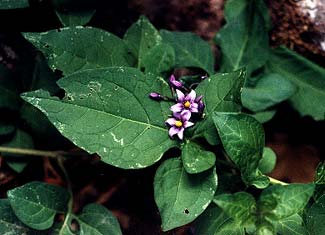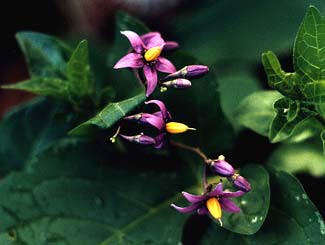
Deadly Nightshade should be
renamed Lovely Nightshade
"What stir of summer re-illume
Our hearts' wreck'd garden-close?
What flowers can fill the empty room
Where now the nightshade grows?"
-John Payne
(1842-1916)
(1842-1916)
A volunteer appeared at the foot of the deck stairs in the back yard, between pavers. It was a very pretty trailing green vine. It hadn't chosen the best location for itself but it wasn't too badly in the way, so I left it, knowing I could pull it out any time if it turned out to be something unwanted.
Granny Artemis by right of having studied botany at university is a hundred times better than I at recognizing things randomly, & she said it was probably some variety of Potato Vine. It has a five-lobed triangular leaf that looks like one large leaf with two smaller leaves at the base of that & another two more leaves still smaller at the base of those. Some of the leaves were only three-lobed. It crept along the ground fairly rapidly & as it matured became woody-stemmed.
Flowers had purple petals with yellow anthers in August & September. The flower looks pretty similar to those on the Blue Potato Vine even though leaves weren't at all similar, & the flower petals were reflexed on this garden volunteer.
With the reflexed petals & deeply lobed triangular leaves, it was finally easily recognized as Solanum dulcamara, the Climbing, Bittersweet, or Deadly Nightshade. It has small oval green berries in late September that slowly turn yellow, orange, then bright red for winter. Some of the berries still cling to the deciduous vines after leaf-fall.
 Though fully naturalized throughout North America & particularly common here in Western Washington, it was originally introduced from Europe, having formerly been held in higher esteem for its sundry medicinal properties.
Though fully naturalized throughout North America & particularly common here in Western Washington, it was originally introduced from Europe, having formerly been held in higher esteem for its sundry medicinal properties.I can remember decades ago, when I was a kid, a fear ran through the neighborhood that Deadly Nightshade could very easily kill children & pets & livestock. Parents up & down the streets were out in force looking for & destroying all sorts of plants they mistook for Deadly Nightshade, & speaking with condemnation at the front doors of anyone who didn't cave in to the general panic.
It certainly is toxic, but no more so than any number of flowers, bulbs, & ornamental fruits nobody worries about. The toxins in Nightshade break down with cooking, so that some people do intentionally eat it prepared. But raw, the berries are inedible even if only because of the terrible flavor. The toxin is found in the roots, shoots, leaves, stems, & green berries; it is not in the fully ripened berries. As with many such plants, it disperses its seeds by permitting birds to eat the fruit & poop the seeds here & there, so the fruit ceases to be toxic when it is ready to be seeded.
Incidents of nightshade poisoning of children or pets are exceedingly rare, as it is only moderately poisonous to start with, besides tasting so awful it is instantly spat out, but if actually swallowed is even then poorly absorbed in the stomach & swiftly excreted. The specific toxin, solanine, is the same as found in the leaves, stems, & green skins of the common dinner potato, which hardly anyone bothers to guard against, even though the most common source of solanine poisoning in livestock is not Nightshade which animals dislike the taste of, but harvested domestic potato tubers.
To ingest enough of Nightshade's solanine to equal a harmful dose would require between one pound & ten pounds of the appallingly bitter berries to be eaten while still green. If anyone really could eat that much, they'd be sorry indeed they had done so. Symptoms from eating that enormous quantity of leaf roughage & green berries would begin with a stomach ache, followed by an unreasoning sense of well being (giddiness), then swiftly progress to vomiting, stomach swelling, paralysis, coma, & not inconcievably death. Of course, another precursor to Nightshade poisoning is pretty much required: one must also be stark raving insane ever to have decided a pound or more of leaves & ghastly bitter berries would be just the thing.
A phobic response to Deadly Nightshade though not entirely baseless is nevertheless by & large silly. It was mainly that name "Deadly" that induced a community panic when I was young, when several Creeping Oregon Grape & Creeping Blueberries torn up & discarded by families that didn't actually know what Nightshade looked like.
Nightshade vines can become invasive. If you permit one in the garden due to its startling beauty, it requires some attention lest it spread & take over & crowd out sensitive things.
I permitted this one to have its way for a full year, but during its second spring it had sprawled in so many directions, was so in the way of the path, & resisted being trained in directions I would have preferred, forcing me to dig up & discard it. If some other specimen someday self-selects a more suitable location to pop up, however, I may permit it to remain indefinitely.